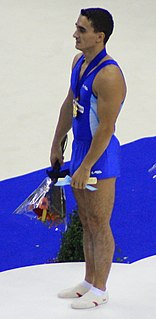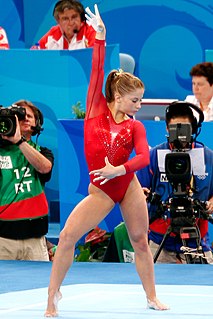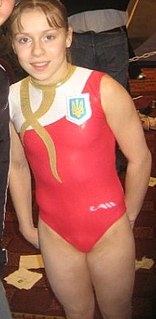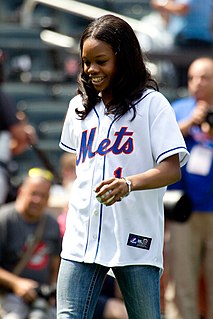Simona Amânar is a Romanian former artistic gymnast. She is a seven-time Olympic and ten-time World Championship medalist. Amânar helped Romania win four consecutive world team titles (1994–1999), as well as the 2000 Olympic team title. She is also the 2000 Olympic all-around champion. She has a vault named after her, one of the most difficult in women's gymnastics, and was inducted into the International Gymnastics Hall of Fame in 2007.

Marian Drăgulescu is a Romanian artistic gymnast. During his senior gymnastics career he has won an impressive 31 medals at Olympic games, and World or European Championships, of which eight are gold medals at the World Championships. He excels in vault and floor, on which he was a multiple world champion and Olympic medallist. His name will remain in gymnastics history not only because of his world titles on floor and vault, but also because of the extremely difficult vault that was named after him: a handspring double front somersault with ½ turn or the Drăgulescu. He was also an excellent all around gymnast, an event in which he was a European champion (2004) and bronze medallist (2000), and placed 8th at the 2004 Olympic Games.

Kyle Keith Shewfelt is a Canadian gymnast. His gold medal in the men's floor exercise competition at the 2004 Athens Olympics was the first medal ever by a Canadian in an artistic gymnastics event and was the first Canadian gold of the 2004 Olympics. He also has a vault named after him.
The Code of Points is a rulebook that defines the scoring system for each level of competition in gymnastics. There is not a universal international Code of Points, and every oversight organization — such as the FIG, NCAA Gymnastics, and most national gymnastics federations — designs and employs its own unique Code of Points.
Cheng Fei is a retired Chinese gymnast. She is a three-time World Champion on the vault (2005–2007) and 2006 World Champion on floor exercise. She was a member of the gold medal-winning Chinese teams for the 2006 World Artistic Gymnastics Championships in Aarhus, Denmark and 2008 Olympic Games in Beijing, China. She was also a member of the silver medal-winning Chinese team for the 2007 World Artistic Gymnastics Championships in Stuttgart, Germany.
Mo Huilan is a retired Chinese gymnast who competed at the 1996 Olympic Games in Atlanta. She was one of China's most successful gymnasts in the 1990s. She was known for performing routines of exceptional difficulty and technique, but also for inconsistency.
Yurchenko is the name of both a specific vault and a vault family in artistic gymnastics. The Yurchenko was named after Soviet gymnast Natalia Yurchenko in 1982 during a competition in Moscow. The first gymnast to actually perform it in a competition was a male gymnast. He was a Russian gymnast and he was the one who actually invented the Yurchenko. His name was Viktor Levinkov.
The Gienger is a gymnastics skill performed on the uneven bars for women and the high bar for men. It is named after German gymnast Eberhard Gienger. The release move looks like a half-turn layout "flyaway" above the bar to catch the same bar. Its COP reference is 3.405 and it is a D element.
This is a general glossary of the terms used in the sport of gymnastics.

Bridget Elizabeth Sloan is an American artistic gymnast. She is the 2009 world champion in the all-around, the 2009 United States national champion, and a silver medalist with the American team at the 2008 Summer Olympics in Beijing.
Ri Se-gwang is a North Korean artistic gymnast, representing the April 25 Sports Club. He can easily be considered a specialist on vault apparatus within the sport of men’s artistic gymnastics.

Shawn Machel Johnson East is an American former artistic gymnast. She is the 2008 Olympic balance beam gold medalist and team, all-around and floor exercise silver medalist. Johnson is also a five-time Pan American Games gold medalist, winning the team titles in 2007 and 2011, as well as titles in the all-around, uneven bars, and balance beam in 2007.
Qiao Ya is a retired Chinese artistic gymnast. She was the 1994 Asian Games All-Around Champion, a finalist on balance beam at the 1994 and 1995 World Gymnastics Championships, and competed at the 1996 Olympic Games in Atlanta – where she placed 11th in the individual All-Around and 4th with the team during Team Finals.

Yana Vladimirovna Demyanchuk is a Ukrainian artistic gymnast who won gold on the balance beam at the 2009 European Artistic Gymnastics Championships.
The Amanar for women is a skill in vault of artistic gymnastics. The vault was named after the first gymnast to perform it at the World Championships or Summer Olympics: Simona Amânar of Romania for women, and Kyle Shewfelt of Canada for men. Both were originated at the 2000 Summer Olympics in Sydney. The vault belongs to the Yurchenko family consisting of a roundoff onto the springboard, back handspring onto the vaulting platform and then 2½ twists into a layout back salto off the table. Although the vault is officially named for two athletes, the Amanar is more popular and often used for both sexes.

Gabrielle Christina Victoria Douglas is an American artistic gymnast. She is the 2012 Olympic all around champion and the 2015 World all-around silver medalist. She was a member of the gold-winning teams at both the 2012 and the 2016 Summer Olympics, dubbed the "Fierce Five" and the "Final Five" by the media, respectively. She was also a member of the gold-winning American teams at the 2011 and the 2015 World Championships.

Yang Hak-seon is a South Korean artistic gymnast who specialises on vault. He is the first South Korean gymnast to win an Olympic gold medal.
There are currently four elements in the Women's Artistic Gymnastics Code of Points named after American gymnast Simone Biles: one on vault, one on balance beam, and two on floor exercise.









